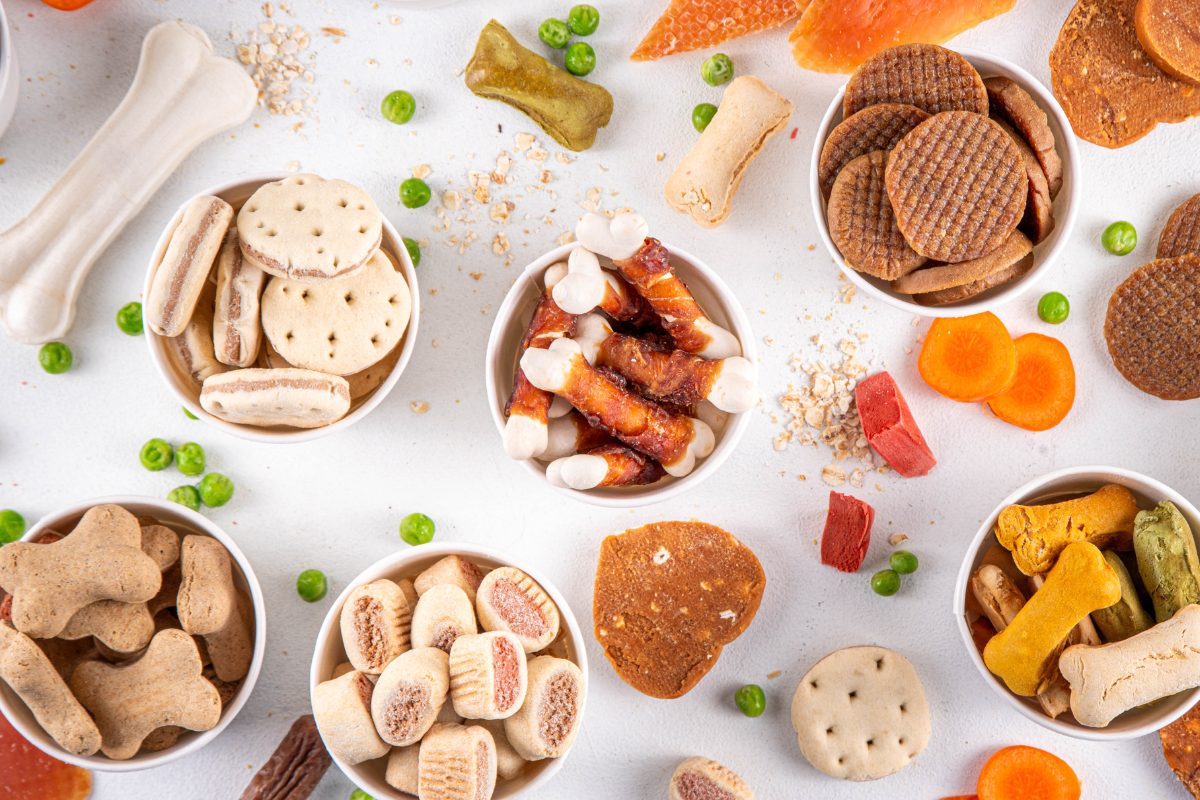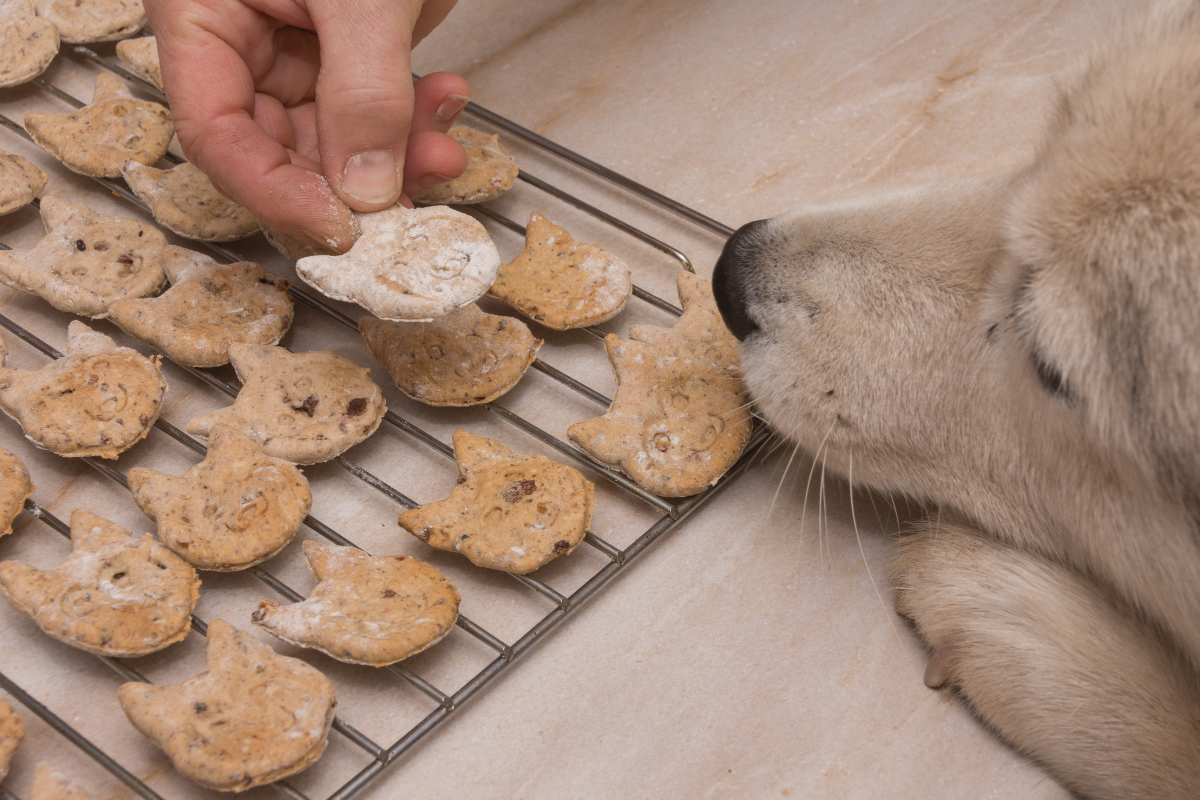- Urbaki Pets
- Dogs
- Healthy Dog Treats Homemade: A Nutritious Way to Pamper Your Pet
Healthy Dog Treats Homemade: A Nutritious Way to Pamper Your Pet
24/09/2024 · Updated on: 28/10/2025

Homemade dog treats can be simple, budget-friendly, and tailored to your pet’s needs. The key is balancing flavor with canine nutrition and safety.
Below you’ll find clear guidance on what to avoid, how much to serve, precise gram/ml measurements, and vet-informed baking and storage tips—plus three reliable recipes your dog will love.
Why Make Your Own Treats
When you bake at home, you control ingredients, texture, and portion size. That means fewer additives, easy swaps for sensitivities, and a chance to reward training without overloading on calories.
Keep the focus on whole foods, moderate fat, and limited sweeteners so treats stay a complement—not a replacement—for balanced meals.
Dog-Safe First: Ingredients to Avoid

Before we turn on the oven, review this quick no-go list. These foods are unsafe for dogs and should never be in your recipes:
Xylitol (often in “sugar-free” peanut butter, gum, syrups)
Chocolate and cocoa powder
Grapes and raisins
Onion and garlic (fresh, powder, cooked—avoid all)
Yeasted raw dough
Macadamia nuts
When in doubt, skip it or ask your vet. Always read labels for hidden xylitol and artificial sweeteners.
Portions & Calories: The 10% Rule
Treats should be no more than 10% of your dog’s daily calories. The remaining 90% should come from a complete, balanced diet.
For small dogs, that may mean one small biscuit per day; for larger dogs, two to three, depending on size and activity. If you’re using treats for training, break them into pea-sized pieces to keep intake modest.
Pantry Staples & Smart Substitutions

Flour: Use whole-wheat or oat flour for fiber. For grain-free, try brown rice flour or buckwheat flour.
Binders: Egg or unsweetened applesauce help hold shape; pumpkin puree adds moisture and fiber.
Healthy fats: Natural peanut butter (100% peanuts, no xylitol) or a touch of olive oil.
Flavor & function: Pumpkin for gentle digestion, banana for sweetness, blueberries for antioxidants.
Low-fat swaps: Replace part of the peanut butter with mashed banana or pumpkin to reduce calories.
Vet-Informed Homemade Treat Recipes
Peanut Butter–Banana Training Bites (Soft, Breakable)

Yield: ~80 pea-sized bites
Prep: 10 min | Bake: 10–12 min
Texture: Soft-chewy for training
Ingredients
130 g oat flour (about 1 ¼ cups)
120 g banana, well mashed (about 1 medium)
60 g natural peanut butter (no xylitol) (about ¼ cup)
60 ml unsweetened applesauce (¼ cup)
1 large egg (≈50 g), lightly beaten
Instructions
Heat oven to 175 °C / 350 °F. Line a tray with parchment.
Mix banana, peanut butter without xylitol, applesauce, and egg. Stir in oat flour to form a thick dough.
Roll into small 1–1.5 cm balls (pea-to-marble size) or pipe dots with a bag.
Bake 10–12 min until set but still soft. Cool completely.
Storage
Refrigerate in an airtight container ≤4 °C / 40 °F for up to 5 days.
Freeze up to 2 months; thaw a handful at a time.
Serving tip: These are rich—break into tiny pieces for calorie-smart training.
Crunchy Pumpkin Oat Biscuits (High-Fiber, Low-Sweetener)

Yield: ~36 small bones or circles
Prep: 15 min | Bake: 18–22 min
Texture: Crunchy
Ingredients
200 g whole-wheat flour (1 ½ cups)
90 g oat flour (¾ cup)
170 g pumpkin puree (¾ cup; plain, unsalted)
60 ml low-sodium chicken broth or water (¼ cup)
30 ml olive oil (2 tbsp)
Optional: ½ tsp ground cinnamon (skip if your vet advises)
Instructions
Heat oven to 180 °C / 350 °F.
Combine flours, then stir in pumpkin, broth, and oil until dough forms.
Roll to 6–8 mm thick (¼–⅓ in). Cut shapes.
Bake 18–22 min until edges are crisp. For extra crunch, switch off oven and leave biscuits inside 10 minutes with door slightly open.
Storage
Room temp in a sealed container for up to 5 days if your kitchen is <27 °C / 80 °F and low humidity.
Refrigerate up to 10 days; freeze up to 3 months.
Serving tip: Great as occasional rewards for larger breeds; halve for small dogs.
Blueberry Yogurt Pupsicles (No-Bake, Summer Favorite)

Yield: ~12 mini molds
Prep: 5 min | Freeze: 4–6 h
Texture: Frozen, lickable
Ingredients
240 ml plain, unsweetened yogurt (1 cup; lactose-free if needed)
80 g blueberries, fresh or frozen (≈⅔ cup)
60 ml unsweetened applesauce (¼ cup)
Splash of water if thinning is needed
Instructions
Blend yogurt, blueberries, and applesauce until smooth.
Pour into silicone molds or an ice tray.
Freeze 4–6 hours until solid.
Storage
Freeze for up to 2 months.
Serving tip: Offer outdoors or on a lick mat to slow intake and minimize mess.
Food Safety & Storage (Essential)

Keep treats safe and fresh with these simple rules:
Temperature control: Refrigerate homemade treats at ≤4 °C / 40 °F.
Clean tools & containers: Wash bowls, spatulas, and storage tubs after each batch; dry completely to avoid moisture buildup.
Label & rotate: Mark date and recipe on containers. Follow first in, first out.
Room-temp window: Only store dry, low-moisture biscuits in a cool, low-humidity space—and only for a few days. If your kitchen runs warm, refrigeration is safer.
Freeze for longevity: Most baked treats freeze well for 2–3 months. Thaw in the fridge, not on the counter.
Special Diet Considerations

Weight control / low-fat: Replace part of the peanut butter in recipes with additional pumpkin or mashed banana; keep treats small and use training-size pieces.
Sensitive stomachs: Choose simple ingredient lists. Start with one new recipe at a time and introduce gradually.
Allergies: Common triggers include chicken, beef, dairy, and wheat. Swap flours (e.g., oat → rice or buckwheat), use lactose-free yogurt, and keep a food diary if symptoms arise.
Senior dogs: Aim for softer textures (the training bites are ideal). Add a splash of water to doughs or bake shorter for more tenderness.
Troubleshooting Texture (Quick Fixes)
Too dry / crumbly: Add 1–2 tbsp water or applesauce; reduce bake time by 2 minutes.
Too wet / sticky: Dust with 1–2 tbsp flour; chill dough 15 minutes before rolling.
Not crunchy enough: Bake 2–3 minutes longer, then rest in the warm oven with the door ajar.
Safety Check Before Every Batch

Read labels to confirm no xylitol and no artificial sweeteners.
Avoid chocolate, grapes/raisins, onion/garlic, yeasted dough, macadamias.
Introduce new treats slowly, watch for itching, GI upset, or changes in stool.
Supervise while your dog eats, especially with new textures or very eager chewers.
Helpful Add-Ons for Your Post (Optional to include)
A mini table summarizing each recipe’s bake time, yield, texture, and storage.
Internal links to related topics (e.g., training with positive reinforcement, canine digestion basics, holiday treat safety) to improve on-site SEO and reader journey.
A short disclaimer: This content is educational and does not replace personalized veterinary advice.
Happy Tails, Healthier Treats

Homemade treats are a lovely way to bond with your dog—and with a few safety-first habits, they can fit neatly into everyday routines.
Keep portions modest with the 10% rule, stick to dog-safe ingredients, and lean on simple, whole-food recipes.
Your reward is a wagging tail, a healthier snack, and the peace of mind that comes from knowing exactly what’s in every bite.
Enjoy The Video About Dogs

Source: AGuyAndAGolden

Urbaki Editorial Team is the collaborative byline behind our pet-care guides. Our writers and editors turn evidence and real-life experience into clear, humane advice on training, wellbeing, nutrition basics, and everyday life with animals. Every article is planned, written, and edited by humans, fact-checked against reputable veterinary sources, and updated over time. This is an editorial pen name—see our Editorial Policy. Educational only; not a substitute for veterinary advice.

You may also like